What does ITshnik like to love some marketers or marketing guide for an IT startup?
“I am an advertiser: yes, yes, it is I who pollute the environment. I am the type that sells you different crap. The one that makes you dream of things that you will never have. About eternally azure skies, about invariably seductive beauties, about perfect happiness, tinted in PhotoShop'e ... To make sure that you constantly drool over your mouth - this is it, my highest goal. In my profession, no one wishes you happiness. After all, happy people do not consume, ”- an excerpt from the novel“ 99 francs ”by Frederick Begbeder.

Yes, because of such marketers as Octave, it’s difficult to pronounce the words “I am a marketer” with pride. In our post-soviet space, marketing is completely overgrown with negative stereotypes ... Someone immediately grimaces about network marketing, someone about some promiscuous advertising and tricks.
')
But in this article I will show you the noble side of marketing that will make your startup successful without any effort. It's about marketing, which benefits the company in the form of profit, and the client - in the form of a solution to its problem.
Here are the main thoughts:
And also, this article is our answer to Chamberlain, that is, Habravchanin, who wrote " What exactly do I hate for some individual marketers ... ".
“The main problem of a startup is not in the product, and not in the technical component, but in marketing”, - from the speech of Rand Fishkin, Moz .
And here is another argument ...
46% of startups fail due to a lack of marketing and management knowledge, NASBP .
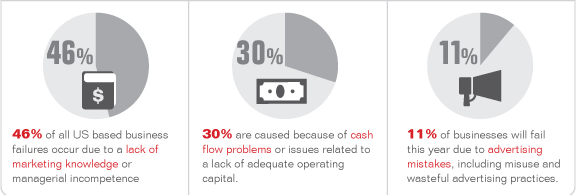
Therefore, if you decide that the main thing is the product and money, but you can think about marketing later, then think again. In the same video, Rand even recommends starting product promotion at the idea stage.
You have to either become a marketer yourself, or take him to the team.
“In the era of mass consumption, marketing was the last thing to think about. Marketing and advertising were synonymous, and the main task was to promote what has already happened. In the era of the Internet, marketing is the product, service, and most importantly, this is what they say about him and those connections that are created thanks to this, ”- Seth Godin , marketing guru.
The most widespread misconception about marketing is that its role is reduced only to promotion.
In fact, marketing needs a startup to:
“Instead of asking the question“ Is it possible to create this product? ”, Better ask yourself“ Do you need to create this product? ”And“ Can we build a successful business with this product? ”,” Eric Rice, author of the best-selling book “ Thrifty startup . "
Contrary to popular belief that marketing = advertising, the first task of a marketer in a startup is to search for an optimal market fitting, namely the answer to the question: "WHAT IS a problem of ANY customers, HOW you decide and WHAT your decision is better than others."
If the answer to this question is initially incorrect, then it makes no sense to go further.
The most popular mistakes of failed startups are, firstly, in the wrong thinking at the stage of the product idea, when forgetting to ask “why”, the engineering brain rushes at full steam, creating another masterpiece; secondly, in the banal ignoring of competitors.
“Great startups solve the obvious, ideally, very large and thorny problems of the clients ... Unfortunately, this was not our case,” revelations of Vinay on Vitoto's Failure, the failed stripper.
Here is one of the most excellent examples of how Emily Brooke , the founder of Blaze , was looking for the idea of her startup and came running with another find - with some special light reflectors for urban cyclists, to her mentor, he told her that this did not solve any of the URBAN urban problems. cyclists, and most importantly, what she needs to do is search for a problem, not a solution. In the end, she found a real problem - a closed review area for motorists, when they simply do not see a cyclist because of what happens the largest number of accidents, and often fatal ones. Her decision is a special laser flashlight that designs the bicycle badge on the road 5-6 meters ahead, so that drivers can see it. As a result, the project received public recognition and won many competitions.
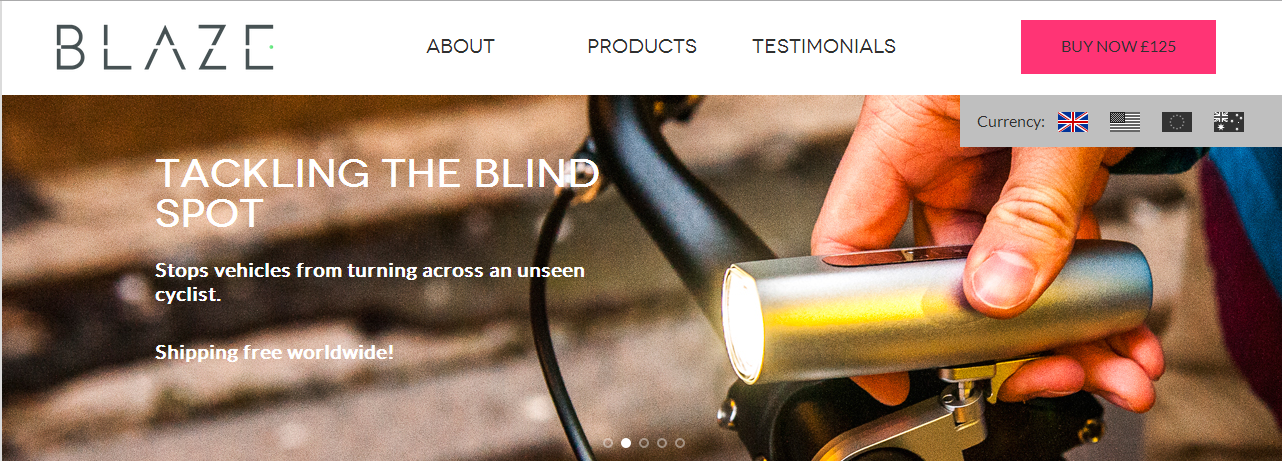
As for me, with a decision that saves lives it is difficult to miss.
When you enter the market with a new product, then there are two options: either solve a customer’s problem that no one has yet solved; either, to solve the same problem as others, but to do it is radically better.
If you are not much different from competitors, and in the case of a startup, you do not have a brand yet, then you will have to compete only in price, and in this battlefield, a startup that has very few resources and no economy of scale will simply not survive.
For example, 37signals products solve the same problems as many other companies, but do it differently. Their products are united by one very important differentiating factor - simplicity.
“We believe that software is too complicated. Too many features, too many buttons, too much learning time. We specifically create products that make less ... ", 37signals.
By the way, their installation “all ingenious is simple” reads in everything they do: in the approach to software development, in books, in marketing, in the website, and even in the recent decision to become a company of one product, abandoning everything except Basecamp. Yes, they are just geniuses of entrepreneurship and marketing ...

⇒ What does a useful marketer do
In order to protect themselves from solving a non-existent problem and creating a second Facebook marketer should:
“You can create an ingenious and very necessary thing, but if you cannot just as well tell investors and potential clients about it, you will have nothing to do with” - this is a clear, but nevertheless clever idea I recently heard from start-up Anatoly Makarevich, Gistroll .
It seems to me that this problem is especially relevant for IT sources, including many introverts, although this may be a stereotype.
The best thing that can happen to you is that you are your target audience, that is, you are going to sell your product the same as you. This simplifies the task a lot.
As in the case of the same guys from 37signals, who created Ruby on Rails , including for themselves, to facilitate their work.

This is the only way that not everyone is lucky and not always, and most likely you are developing a product for a person from a parallel world.
When it comes time to formulate your idea, start-ups often make two mistakes ...

Heating time, max. temperature, ceramic coating, ionization ... hmm, says nothing.
“The automation system“ X ”is a universal multi-functional process management software for small and medium enterprises”, this is a description of an existing product, which I will not mention for understandable reasons. After reading this subscript, you have even the slightest idea what it is and why?
⇒ What does a useful marketer do
To your pitch-and ignite the eyes of customers and investors, and in the end you heard the magic: “I want! Wrap two! ”, Follow these rules:
For these purposes, there is a wonderful tool called " ideal buyer " (Buyer Persona), a collective image of the core of your target audience. A fairly detailed profile of the client is created, which includes all the information that may in one way or another be connected with the decision to purchase your product / service. It turns out a certain Inokentiy for whom the marketing material is created.
Here is a good illustration of the difference between features and benefits.
Like most startups sell their product / service:

How startups should sell their product / service:
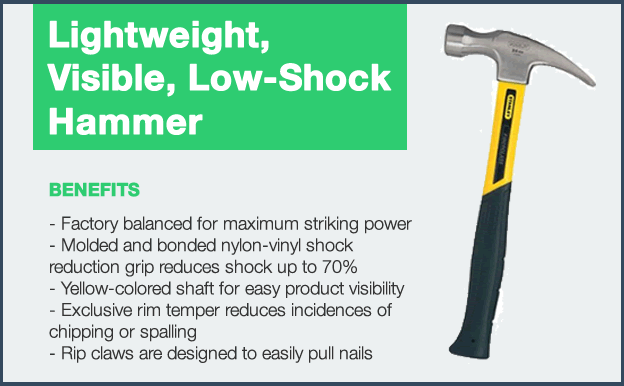
In the first case, we just have a hammer 2.0 and an enumeration of how and what it is made of, and in the second case, we are immediately shown what the chip of this hammer is (“Lightweight, noticeable, with weak feedback”), and then explain why the user of this hammer of the listed features (for example: “Balanced at the factory to ensure maximum impact force”).
To translate specifications into the client's language, ask three questions:
Why do we include this feature / feature in our product at all?
What problem does the client solve?
What does your client get as a result of this?
By answering the third question, you finally get the very "benefit" that will be clear to your client.
A clear description with seductive benefits is good, but still does not cling to a potential client to the extent to tell everyone around you. Here, without the favorite of Americans, storytelling is not enough.
How did you come to the idea of your product and how are you going to change the world with it? How did you with one leg and one eye, without money, when no one believed in you at all, created this miracle? .. Of course, all this should be true, because you really didn’t just decide to plow day and night, putting hard-earned money, without any guarantee of success ?!
Rand Fishkin, the founder of Moz , almost in each of his speeches, certainly talks about how he opened a consulting company with his mom in debt, shows on the chart how his debts grew until he could not pay interest and he was already looking for creditors, how lucky he was with his future wife, who suffered it all ... well, and eventually, as they were reformatted from consulting to a software company and everything turned out, now Moz has turned into a multi-million monster.

Despite the soul-saving trainings, articles and books from "experienced", there is still an opinion among IT startups: "A good product sells itself." Therefore, many people fully focus on creating a product, spend on it all or almost all of the resources, and the fact that it also needs to be promoted is remembered last.
In fact, to figure out how to make a lot of the right people know about your product, while spending the few kopecks that a startup has - this is the same art as creating the product itself.
Here, startupers often make two common mistakes: they put all the money into unsuccessful promotion methods and / or incorrectly use “free” promotion channels (talking about blogs and social networks).
Often, unknowingly, wanting to get quick results, start-ups put everything on contextual advertising in search engines and social networks, plus they can also add banner ads in specialized media, and advertising at events (conferences, all kinds of camps and weekends).
These are all good methods, only exceptionally you will not be full of them, in the sense that only by advertising a rare startup can ensure the level of sales necessary for survival. Just not enough money.
Not to mention that even though such an advertisement is the least of all evils, it is still not the most useful type of marketing from the point of view of the client.
As in all other cases, with the advancement, a startup needs a hack, that is, a way to get more for less.
Rand Fishkin boasts that until 2010 they did not pay at all for attracting customers (I mean Paid Customer Acquisition).
And the picture below shows their alignment of channels to attract customers to the current moment (laying out a presentation). Blue-blue segments - paid channels, the rest - "free". Of course, they are not free, because you still need to invest in high-quality man-hours, but the brain is the main asset of a startup!
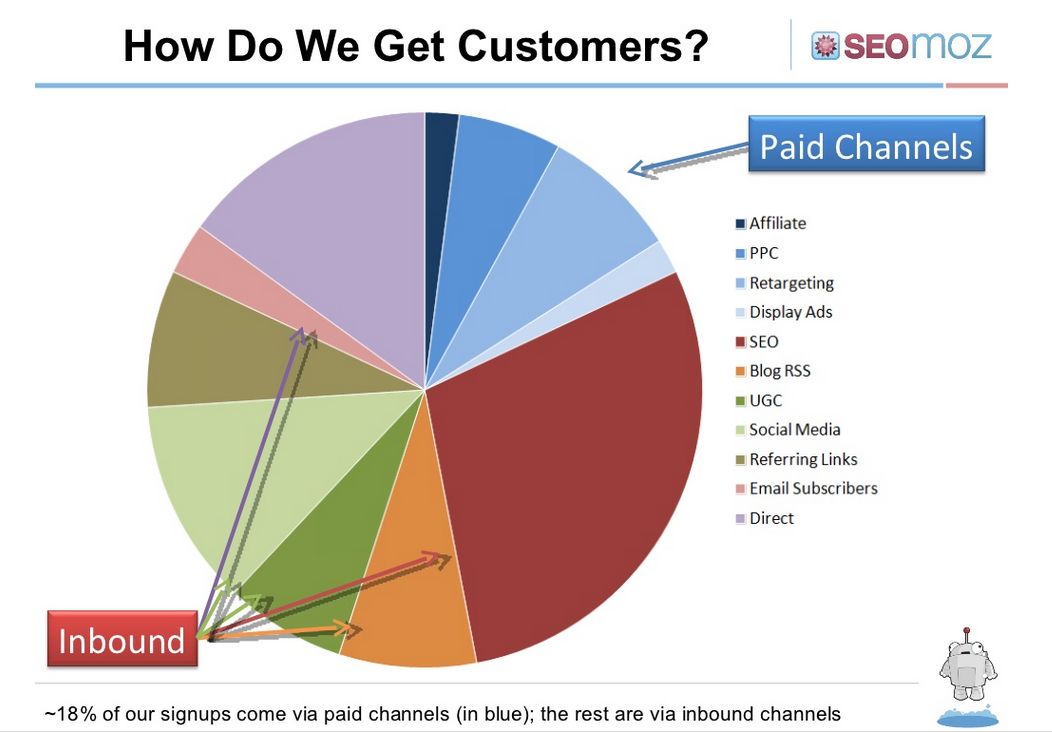
And if in general you look at the ratio of money invested in paid and “free” channels, it turns out that the main potential lies in the “free” promotion ...
At the same time, if you look at the entire global Internet marketing, in 2012 $ 5 billion was spent on “free” channels, which generated 90% of traffic, and paid $ 40 billion and which generated only 10% of traffic (Forrester).
If this does not convince you to look for alternatives to paid advertising, then I do not know what then.
As I have already said, free channels are: company blog, pages and groups in social networks, newsletters, expert blogs and industry portals.
Most often there is such a scenario ... A company that hardly collected a handful of blog readers, newsletter subscribers, page followers or groups on the social network, perhaps even paid for this contextual advertising, hopes that this audience will continue to grow in inverse proportion to itself. At the same time, the startup person thinks: “Hurray! Free site for advertisements ”, and let's bomb subscribers with updates, promotions and discounts.

“- Here are the new pictures of my child!
- I just returned from the alumni meeting!
- (advertising post) Did you know that we have 7 sandwiches that contain less than 6 grams of fat?
If you are going to get into our tape, at least say something interesting. ”- Tom Fishburne, Marketoonist .
And you yourself, how about this content? Probably, just like your users - to put it mildly, bad. Needless to say, this is not working.
There is another caste, and most likely you are from it. You understand that you can promote a company with the help of high-quality training or entertaining content. Only one Habraeffekt, what is it worth!

At the same time, often companies, not having clear guidelines , create their content without knowing:
What kind of content will be interesting to the target audience?
What content, ultimately, will contribute to the achievement of the company's goals (including sales)?
If you create content on a case-by-case basis, choose a topic, relying only on intuition, and have little idea how exactly this or that content will produce the results you need for your business, then you work harder than you need and get less than you could.
⇒ What does a useful marketer do
There is, in general, only one way to promote your product for the benefit of both the company and its customers at the same time - content marketing.
“Content marketing is a marketing hack,” - Rand Fishkin.
Content marketing implies promotion of the company with the help of useful content, when the place to “shove” clients the advertisement of their product, for which you also pay, customers find you by reading an informative article, viewing a useful video, etc.
This is the “free” promotion mentioned above.
For a small startup Groove (SaaS solution for technical support), content marketing has become one of the most important success factors. They launched a blog called " The path to the first $ 100,000 " (talking about revenue per month).

This is a series of articles in which they honestly describe their ups and downs, and most importantly, they draw very valuable conclusions so that readers, if possible, learn from their mistakes. To date, Groove's revenue has already exceeded the $ 50,000 / month mark. And now, when they are asked the most popular question: “Where do you get customers?”, They answer: “Right here, on our blog.” Alex says their blog is the largest source of customers. Now the blog has become their brand.They say with confidence that they would not have reached the goal of $ 50,000 without this project.
Not all content marketing is helpful. You can write articles day and night that are not interesting to anyone, but you can write just mind-blowing viral articles that will generate tons of traffic and, at the same time, 0 sales. Here, in my opinion, the main important steps that separate amateurs from pros are in content marketing ...
Content marketing should give a long-term competitive advantage. The web already has an ocean of information “about everything in the world”, another blog about Agile programming, another group in Facebook about cooking is a waste of resources. You must find your personal island, which will be only yours, in the information space, and, accordingly, in the minds of your potential users.
To do this, you need a big idea - this is your unique perspective on solving the problem of your customers, of which your product is a part.
The great idea of 37signals is simplicity. Yes, I continue to admire how they develop this topic in all areas of business. One of the best examples is their book Rework, on how to create and manage a company, getting rid of everything superfluous and in my head and around.
“Do not invest in any promotion channel until you understand what kind of buying process your customer is going through,” - Rand Fishkin.
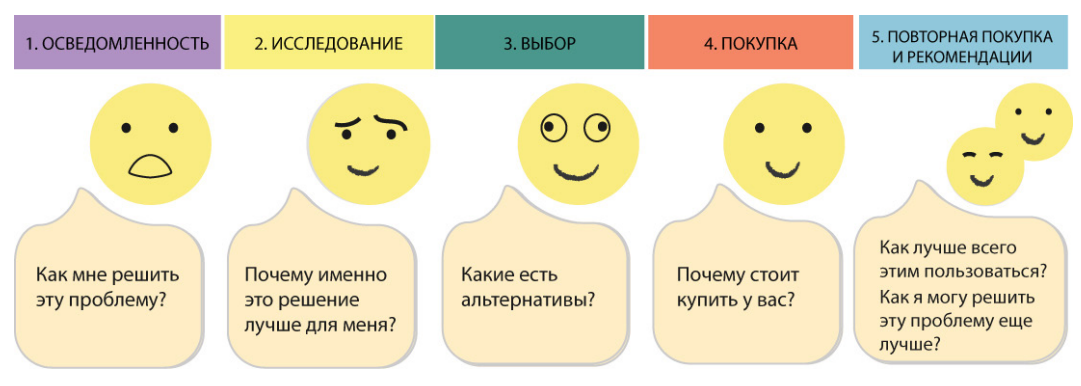
You have already heard that there are potential customers who are ready to put money on the table right now, and there are those who might have been very helpful in what you are selling, but they still don’t know about it. So, the second is much more. And if you help them, answering their questions at every stage of the purchase, providing relevant, necessary and interesting information - they will remember, love and enrich you.
Here are a couple of examples of how Moz does it:

Stage (purchases) 1: Awareness
Guide for SEO for beginners“- Rand says that their customers are not teapots, as the use of Moz software products requires a certain level of knowledge and skills in Internet marketing. Moz marketers create free training content for beginners just to bring them to the desired level.
Stage 2: Research
" 25 steps to master SEO-skill " - a collection of optimization tips for search engines.
Webinars and a number of articles that also contribute to increasing the self-awareness of potential users.
Stage 3: Selecting
Product Information and Terms .
Cases .
Step 4: Purchase
Download a demo version .
The answer to the question: “ Why is Moz? ".
Step 5: Re-buying and recommending
Moz-academy , where paid subscribers to the company's products, can be further educated in the field of Internet marketing.
In fact, Moz has much more content for each of the purchase stages, these are just a few examples.
***
So, to summarize ... Proper marketing is responsible for both the product and its promotion.
At the idea and product creation stage, market research and competitive analysis will help you understand what your potential customers really need. After all, selling something that someone really, really needs is much easier and, what not to say, more pleasant.
If your future users and investors are in a completely different habitat, which means they think in other categories than you do, pay special attention to your pitch. Speak in their language, that they care and forget, though not for long, about features. Also, remember that people buy from people, not from companies, so tell them your story.
Start thinking about promotion as early as possible. Promote your product with useful content, thereby benefiting your customers. Find your big idea for this so that customers remember who you are and what you stand for. And creating content think about what he wants to know and what your potential user needs to know.
I hope I managed to show you the noble side of marketing, and now harmful stereotypes will not prevent you from building an outstanding startup.

Yes, because of such marketers as Octave, it’s difficult to pronounce the words “I am a marketer” with pride. In our post-soviet space, marketing is completely overgrown with negative stereotypes ... Someone immediately grimaces about network marketing, someone about some promiscuous advertising and tricks.
')
But in this article I will show you the noble side of marketing that will make your startup successful without any effort. It's about marketing, which benefits the company in the form of profit, and the client - in the form of a solution to its problem.
Here are the main thoughts:
- Marketing - the cornerstone for business and startup, in particular
- Marketing is not exactly what you think.
- You can do marketing and not be a bastard.
And also, this article is our answer to Chamberlain, that is, Habravchanin, who wrote " What exactly do I hate for some individual marketers ... ".
Don't even start marketing
“The main problem of a startup is not in the product, and not in the technical component, but in marketing”, - from the speech of Rand Fishkin, Moz .
And here is another argument ...
46% of startups fail due to a lack of marketing and management knowledge, NASBP .

Therefore, if you decide that the main thing is the product and money, but you can think about marketing later, then think again. In the same video, Rand even recommends starting product promotion at the idea stage.
You have to either become a marketer yourself, or take him to the team.
Marketing is not exactly what you think.
“In the era of mass consumption, marketing was the last thing to think about. Marketing and advertising were synonymous, and the main task was to promote what has already happened. In the era of the Internet, marketing is the product, service, and most importantly, this is what they say about him and those connections that are created thanks to this, ”- Seth Godin , marketing guru.
The most widespread misconception about marketing is that its role is reduced only to promotion.
In fact, marketing needs a startup to:
- do something that someone really needs
- talk about it so that you understand and imbued
- attract enough customers to stop eating scraps and sleep on a friend's rug.
1st marketing function: to help the company do what someone really needs
“Instead of asking the question“ Is it possible to create this product? ”, Better ask yourself“ Do you need to create this product? ”And“ Can we build a successful business with this product? ”,” Eric Rice, author of the best-selling book “ Thrifty startup . "
Contrary to popular belief that marketing = advertising, the first task of a marketer in a startup is to search for an optimal market fitting, namely the answer to the question: "WHAT IS a problem of ANY customers, HOW you decide and WHAT your decision is better than others."
If the answer to this question is initially incorrect, then it makes no sense to go further.
The most popular mistakes of failed startups are, firstly, in the wrong thinking at the stage of the product idea, when forgetting to ask “why”, the engineering brain rushes at full steam, creating another masterpiece; secondly, in the banal ignoring of competitors.
- Problem number 1: The solution to a non-existent problem
“Great startups solve the obvious, ideally, very large and thorny problems of the clients ... Unfortunately, this was not our case,” revelations of Vinay on Vitoto's Failure, the failed stripper.
Here is one of the most excellent examples of how Emily Brooke , the founder of Blaze , was looking for the idea of her startup and came running with another find - with some special light reflectors for urban cyclists, to her mentor, he told her that this did not solve any of the URBAN urban problems. cyclists, and most importantly, what she needs to do is search for a problem, not a solution. In the end, she found a real problem - a closed review area for motorists, when they simply do not see a cyclist because of what happens the largest number of accidents, and often fatal ones. Her decision is a special laser flashlight that designs the bicycle badge on the road 5-6 meters ahead, so that drivers can see it. As a result, the project received public recognition and won many competitions.

As for me, with a decision that saves lives it is difficult to miss.
- Problem number 2: All the same, only in profile
When you enter the market with a new product, then there are two options: either solve a customer’s problem that no one has yet solved; either, to solve the same problem as others, but to do it is radically better.
If you are not much different from competitors, and in the case of a startup, you do not have a brand yet, then you will have to compete only in price, and in this battlefield, a startup that has very few resources and no economy of scale will simply not survive.
For example, 37signals products solve the same problems as many other companies, but do it differently. Their products are united by one very important differentiating factor - simplicity.
“We believe that software is too complicated. Too many features, too many buttons, too much learning time. We specifically create products that make less ... ", 37signals.
By the way, their installation “all ingenious is simple” reads in everything they do: in the approach to software development, in books, in marketing, in the website, and even in the recent decision to become a company of one product, abandoning everything except Basecamp. Yes, they are just geniuses of entrepreneurship and marketing ...

⇒ What does a useful marketer do
In order to protect themselves from solving a non-existent problem and creating a second Facebook marketer should:
- Conduct market research to select a problem and understand the audience.
- Analyze competitors to find their place in the market and compare favorably with the rest.
- Participate in the development of the concept of the product, to be the lawyer of the future buyer and look at it with his eyes
- Test the first and subsequent prototypes and correctly interpret user feedback.
2nd marketing function: talk about the product so that it is understood and imbued
“You can create an ingenious and very necessary thing, but if you cannot just as well tell investors and potential clients about it, you will have nothing to do with” - this is a clear, but nevertheless clever idea I recently heard from start-up Anatoly Makarevich, Gistroll .
It seems to me that this problem is especially relevant for IT sources, including many introverts, although this may be a stereotype.
The best thing that can happen to you is that you are your target audience, that is, you are going to sell your product the same as you. This simplifies the task a lot.
As in the case of the same guys from 37signals, who created Ruby on Rails , including for themselves, to facilitate their work.

This is the only way that not everyone is lucky and not always, and most likely you are developing a product for a person from a parallel world.
When it comes time to formulate your idea, start-ups often make two mistakes ...
- Problem number 1: Throw a potential user who has just fallen out of a sledge with incomprehensible terminology and transfer of features

Heating time, max. temperature, ceramic coating, ionization ... hmm, says nothing.
- Problem number 2: instead of the description - a zero calorie content consisting of abstract words that would also fit into the top ten other products
“The automation system“ X ”is a universal multi-functional process management software for small and medium enterprises”, this is a description of an existing product, which I will not mention for understandable reasons. After reading this subscript, you have even the slightest idea what it is and why?
⇒ What does a useful marketer do
To your pitch-and ignite the eyes of customers and investors, and in the end you heard the magic: “I want! Wrap two! ”, Follow these rules:
- Refer to a specific person who will use your product or who should be enriched thanks to you (the investor) with perfect installations, stereotypes and problems, and not to a male audience from 18 to 45 who work in the office and wear sneakers.
For these purposes, there is a wonderful tool called " ideal buyer " (Buyer Persona), a collective image of the core of your target audience. A fairly detailed profile of the client is created, which includes all the information that may in one way or another be connected with the decision to purchase your product / service. It turns out a certain Inokentiy for whom the marketing material is created.
- Focus not on features, but on why your user needs them.
Here is a good illustration of the difference between features and benefits.
Like most startups sell their product / service:

How startups should sell their product / service:

In the first case, we just have a hammer 2.0 and an enumeration of how and what it is made of, and in the second case, we are immediately shown what the chip of this hammer is (“Lightweight, noticeable, with weak feedback”), and then explain why the user of this hammer of the listed features (for example: “Balanced at the factory to ensure maximum impact force”).
To translate specifications into the client's language, ask three questions:
Why do we include this feature / feature in our product at all?
What problem does the client solve?
What does your client get as a result of this?
By answering the third question, you finally get the very "benefit" that will be clear to your client.
- Tell a story - “Tell it, Don't Sell it”
A clear description with seductive benefits is good, but still does not cling to a potential client to the extent to tell everyone around you. Here, without the favorite of Americans, storytelling is not enough.
How did you come to the idea of your product and how are you going to change the world with it? How did you with one leg and one eye, without money, when no one believed in you at all, created this miracle? .. Of course, all this should be true, because you really didn’t just decide to plow day and night, putting hard-earned money, without any guarantee of success ?!
Rand Fishkin, the founder of Moz , almost in each of his speeches, certainly talks about how he opened a consulting company with his mom in debt, shows on the chart how his debts grew until he could not pay interest and he was already looking for creditors, how lucky he was with his future wife, who suffered it all ... well, and eventually, as they were reformatted from consulting to a software company and everything turned out, now Moz has turned into a multi-million monster.

3rd marketing function: attract enough customers to survive and thrive
Despite the soul-saving trainings, articles and books from "experienced", there is still an opinion among IT startups: "A good product sells itself." Therefore, many people fully focus on creating a product, spend on it all or almost all of the resources, and the fact that it also needs to be promoted is remembered last.
In fact, to figure out how to make a lot of the right people know about your product, while spending the few kopecks that a startup has - this is the same art as creating the product itself.
Here, startupers often make two common mistakes: they put all the money into unsuccessful promotion methods and / or incorrectly use “free” promotion channels (talking about blogs and social networks).
- Problem number 1: when they spend all or almost all on paid ways to promote
Often, unknowingly, wanting to get quick results, start-ups put everything on contextual advertising in search engines and social networks, plus they can also add banner ads in specialized media, and advertising at events (conferences, all kinds of camps and weekends).
These are all good methods, only exceptionally you will not be full of them, in the sense that only by advertising a rare startup can ensure the level of sales necessary for survival. Just not enough money.
Not to mention that even though such an advertisement is the least of all evils, it is still not the most useful type of marketing from the point of view of the client.
As in all other cases, with the advancement, a startup needs a hack, that is, a way to get more for less.
Rand Fishkin boasts that until 2010 they did not pay at all for attracting customers (I mean Paid Customer Acquisition).
And the picture below shows their alignment of channels to attract customers to the current moment (laying out a presentation). Blue-blue segments - paid channels, the rest - "free". Of course, they are not free, because you still need to invest in high-quality man-hours, but the brain is the main asset of a startup!

And if in general you look at the ratio of money invested in paid and “free” channels, it turns out that the main potential lies in the “free” promotion ...
At the same time, if you look at the entire global Internet marketing, in 2012 $ 5 billion was spent on “free” channels, which generated 90% of traffic, and paid $ 40 billion and which generated only 10% of traffic (Forrester).
If this does not convince you to look for alternatives to paid advertising, then I do not know what then.
- Problem number 2: incorrectly use the "free" promotion channels
As I have already said, free channels are: company blog, pages and groups in social networks, newsletters, expert blogs and industry portals.
Most often there is such a scenario ... A company that hardly collected a handful of blog readers, newsletter subscribers, page followers or groups on the social network, perhaps even paid for this contextual advertising, hopes that this audience will continue to grow in inverse proportion to itself. At the same time, the startup person thinks: “Hurray! Free site for advertisements ”, and let's bomb subscribers with updates, promotions and discounts.

“- Here are the new pictures of my child!
- I just returned from the alumni meeting!
- (advertising post) Did you know that we have 7 sandwiches that contain less than 6 grams of fat?
If you are going to get into our tape, at least say something interesting. ”- Tom Fishburne, Marketoonist .
And you yourself, how about this content? Probably, just like your users - to put it mildly, bad. Needless to say, this is not working.
There is another caste, and most likely you are from it. You understand that you can promote a company with the help of high-quality training or entertaining content. Only one Habraeffekt, what is it worth!

At the same time, often companies, not having clear guidelines , create their content without knowing:
What kind of content will be interesting to the target audience?
What content, ultimately, will contribute to the achievement of the company's goals (including sales)?
If you create content on a case-by-case basis, choose a topic, relying only on intuition, and have little idea how exactly this or that content will produce the results you need for your business, then you work harder than you need and get less than you could.
⇒ What does a useful marketer do
There is, in general, only one way to promote your product for the benefit of both the company and its customers at the same time - content marketing.
“Content marketing is a marketing hack,” - Rand Fishkin.
Content marketing implies promotion of the company with the help of useful content, when the place to “shove” clients the advertisement of their product, for which you also pay, customers find you by reading an informative article, viewing a useful video, etc.
This is the “free” promotion mentioned above.
For a small startup Groove (SaaS solution for technical support), content marketing has become one of the most important success factors. They launched a blog called " The path to the first $ 100,000 " (talking about revenue per month).

This is a series of articles in which they honestly describe their ups and downs, and most importantly, they draw very valuable conclusions so that readers, if possible, learn from their mistakes. To date, Groove's revenue has already exceeded the $ 50,000 / month mark. And now, when they are asked the most popular question: “Where do you get customers?”, They answer: “Right here, on our blog.” Alex says their blog is the largest source of customers. Now the blog has become their brand.They say with confidence that they would not have reached the goal of $ 50,000 without this project.
Not all content marketing is helpful. You can write articles day and night that are not interesting to anyone, but you can write just mind-blowing viral articles that will generate tons of traffic and, at the same time, 0 sales. Here, in my opinion, the main important steps that separate amateurs from pros are in content marketing ...
- Find your big idea
Content marketing should give a long-term competitive advantage. The web already has an ocean of information “about everything in the world”, another blog about Agile programming, another group in Facebook about cooking is a waste of resources. You must find your personal island, which will be only yours, in the information space, and, accordingly, in the minds of your potential users.
To do this, you need a big idea - this is your unique perspective on solving the problem of your customers, of which your product is a part.
The great idea of 37signals is simplicity. Yes, I continue to admire how they develop this topic in all areas of business. One of the best examples is their book Rework, on how to create and manage a company, getting rid of everything superfluous and in my head and around.
- Understand which way to buy a client passes and help him go this way.
“Do not invest in any promotion channel until you understand what kind of buying process your customer is going through,” - Rand Fishkin.

You have already heard that there are potential customers who are ready to put money on the table right now, and there are those who might have been very helpful in what you are selling, but they still don’t know about it. So, the second is much more. And if you help them, answering their questions at every stage of the purchase, providing relevant, necessary and interesting information - they will remember, love and enrich you.
Here are a couple of examples of how Moz does it:

Stage (purchases) 1: Awareness
Guide for SEO for beginners“- Rand says that their customers are not teapots, as the use of Moz software products requires a certain level of knowledge and skills in Internet marketing. Moz marketers create free training content for beginners just to bring them to the desired level.
Stage 2: Research
" 25 steps to master SEO-skill " - a collection of optimization tips for search engines.
Webinars and a number of articles that also contribute to increasing the self-awareness of potential users.
Stage 3: Selecting
Product Information and Terms .
Cases .
Step 4: Purchase
Download a demo version .
The answer to the question: “ Why is Moz? ".
Step 5: Re-buying and recommending
Moz-academy , where paid subscribers to the company's products, can be further educated in the field of Internet marketing.
In fact, Moz has much more content for each of the purchase stages, these are just a few examples.
***
So, to summarize ... Proper marketing is responsible for both the product and its promotion.
At the idea and product creation stage, market research and competitive analysis will help you understand what your potential customers really need. After all, selling something that someone really, really needs is much easier and, what not to say, more pleasant.
If your future users and investors are in a completely different habitat, which means they think in other categories than you do, pay special attention to your pitch. Speak in their language, that they care and forget, though not for long, about features. Also, remember that people buy from people, not from companies, so tell them your story.
Start thinking about promotion as early as possible. Promote your product with useful content, thereby benefiting your customers. Find your big idea for this so that customers remember who you are and what you stand for. And creating content think about what he wants to know and what your potential user needs to know.
I hope I managed to show you the noble side of marketing, and now harmful stereotypes will not prevent you from building an outstanding startup.
Source: https://habr.com/ru/post/234831/
All Articles